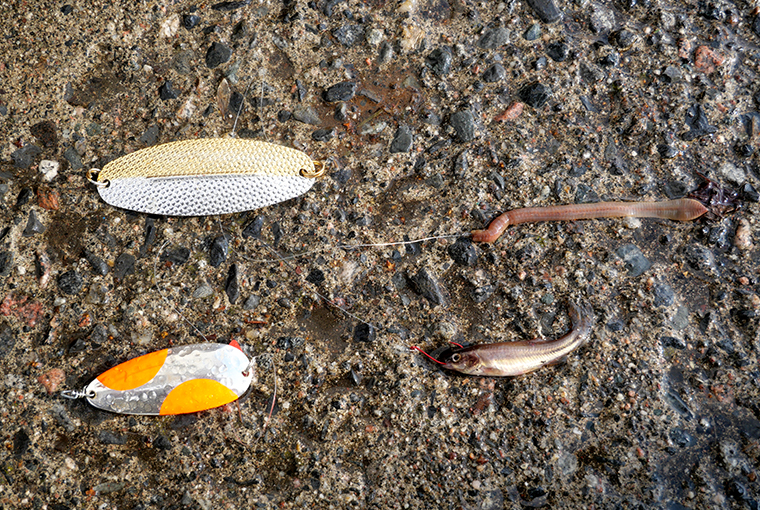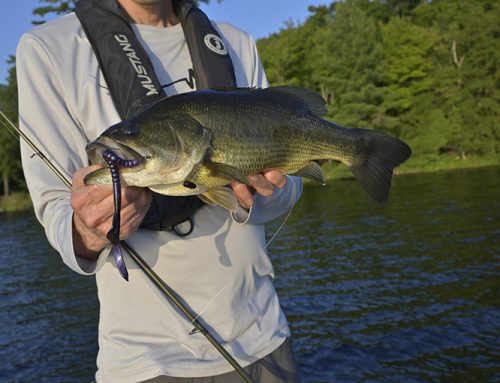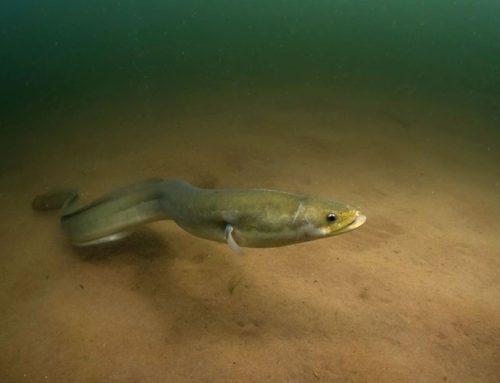
Our rod tips danced rhythmically as I moved the boat along a sheer rock wall. The sonar showed us in 20 feet of water, but I knew from experience that brook trout would be suspended and holding tight to the shelf.
We were trolling Williams Warbler spoons — one silver, one brass — at a touch less than two miles-per-hour (3.2 km/h). Each had the treble hook replaced with a six-inch, 12-pound test monofilament dropper and a #4 Gamakatsu Octopus hook, baited with half a Berkley Gulp night crawler. The spoons were running about 75 feet behind the boat. One was weighted with a 1 ⁄2-ounce rubber core sinker, the other with a 3⁄8-ouncer.
As we continued along the rock wall, I could see my rod tip start to bend back from a strike. I snatched it and set the hook. It felt like a good brook trout; it stayed deep, pumping hard below the boat. My partner reeled in his line and grabbed the net as I fought the fish. After a couple of minutes, the brookie surfaced as the net was readied.
The fish was perfectly hooked in the corner of the mouth, and the glistening silver Williams spoon was a perfect complement to its gorgeous colours. The hook was twisted out and the trout released back into the clear lake water. Trolling a hardware and bait combo had paid off again.
In Quebec, trolling a spoon and/or spinner with a dropper and bait is one of the top techniques for brook trout, in particular. In Ontario, however, this old-school tactic is not as well used. It works for all trout species and in nearly every possible situation. This technique requires two components: a spoon or spinner as the attractor, and a trailing bait to bat cleanup.
My attractor picks
The Williams Warbler: a go-to as it has great action at slow speeds and throws off a lot of flash. The larger the waterbody, the better it works.
The Lake Clear Spoon: a proven winner on inland lakes. Its shape and design work well at very slow speeds, and 1 ⁄3-ounce weight spoons are excellent in shallow water. Use the 3⁄5-ouncer to get down a bit deeper.
Lucky Strike Half Wave Spoon: A four- or five-incher is another excellent choice, with real flash on the troll.
EGB Spoons: Traditional trout casting spoons will also work with a dropper and bait and may be easily adapted for trolling. I like EGB spoons because of their good wobble and excellent flash. The more compact body of a casting spoon makes it sink faster so extra weight may not be needed.
Mepps Comet: I’m a big fan of the Comet #3 or #4 with white blade and red dots. I was turned onto this spinner by an angler in Longlac. It has proven its worth on splake, brook trout, and rainbows. It’s just a killer.
Panther Martin Spinners: these sonic blades throw a ton of vibration. The 7 ⁄16– and 3 ⁄10-ounce versions work well, and there is a wide variety of blade colours and bodies to choose from (including one called HolyRoe).
My dropper bait picks
Worm: The number one live bait is half a night- crawler or a whole garden worm. Thread the worm head onto the hook and leave a short piece trailing. If you leave too much worm, trout will snatch it off without getting hooked.
Minnow: A live or dead minnow works, but use small or medium-sized ones, not large. Thread the minnow through the mouth and out through the top of the head. If you use a longer shanked hook, like a #2 or #4 Carlisle, you can thread the hook through the entire body of the minnow.
Leech: Can be effective for trout in summer.
Berkley Gulp: If you prefer artificial alternatives (and I do) there are many options. Berkley Gulp crawlers and minnows are excellent and I’ve found them more resilient on the hook.
Mister Twister Exude Nymphs: These are worth a try. Even a plastic twister, grub, or tube can be used as a trailer. Don’t be afraid to experiment. Try trolling hardware with bait this season and expect to be impressed. It’s a real sleeper.
How to troll it
The beauty of a trolling set-up like this is you can cover so much water. I’ve found that working a shoreline, over reefs, and along rock ledges can be especially productive. In the summer, when trout are deeper, add some extra weight to get down and troll the basin. Some anglers will even use lead core line to get down consistently to 20 or 30 feet.
Test the action of your lure at various speeds. Not all spoons run well at slow speeds, and not all spinners need to be trolled fast. Little adjustments can make a big difference.
Remove the treble of your spoon or spinner and add a four- to six-inch dropper with #4 or #6 octopus hook. The dropper line can be 10- to 14-pound monofilament or fluorocarbon.
Trout are rarely line shy when bait is trolled behind a lure.
Originally published in the Spring 2024 issue of Ontario OUT of DOORS






Leave A Comment